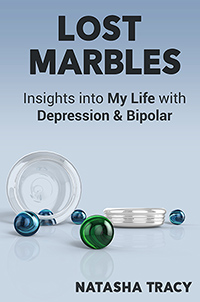Custom Bipolar Mood Scales for the T2 Mood Tracker
As requested, I’m going to provide the details on the custom mood / variables I use in the T2 Mood Tracker. These are just my variables, they certainly don’t have to be yours, but they might be good to glance over.
Custom Moods / Variables I Use to Improve Mood Tracking
As I mentioned, the more difficult a case you are, and boy am I difficult, the more challenging the patterns can be to find. This is why I’ve included these extra variables. Custom moods / variables include:
- Sleep
- Exercise
- Hypomania
- Physical
Bipolar Mood Variables – Sleep
I consider sleep to be, by far, the number one predictor of mood. If I don’t sleep, my day is fucked. Pretty much that simple. Even understanding this as I do, tracking sleep is useful to see what other effects sleep has and possibly what effects how I sleep.
Sleep Rating Scales
Due to my sleeping patterns here are my sleep rating scales (rating scale labels are one word only, thus the following):
- 4hrs – 8hrs
- RestlessAllNight – SleptStraightThrough
- 5NightSweats – 0NightSweats
- Exhausted – Rested
 Bipolar Mood Variables – Exercise
Bipolar Mood Variables – Exercise
I’m not a good one for this, but evidence shows exercise is good for mood. I’ve never, personally, seen it work for me, but clinically it should. I’m tracking it to see any effect it might be having that I haven’t noticed. Like, perhaps on sleep, and then sleep effects mood.
Exercise Rating Scale
- 0hr – 2hr
Bipolar Mood Variables – Hypomania
Hypomania or mania for those with bipolar disorder type 1, is critical to track. These moods often start out feeling good and we miss their beginnings. Then, before you know it, you’re talking to the wind and driving with your eyes closed. Wouldn’t it be great if a simple, little graph warned you ahead of time? Thought so.
Hypomania Rating Scales
These rating scales are taken directly from the diagnostic criteria for a hypomanic episode.
- RacingThought – Normal
- RapidSpeech – Normal
- HighEnergy – Normal
- Grandiose – Normal
- Distractable – Focused
- Jittery – Calm
- HighRiskProne – Normal
- Euphoria – Normal
- Irritable – EasyGoing
Because I have bipolar disorder type 2, I didn’t include any psychosis symptoms, but if you have bipolar 1, you should.
Bipolar Mood Variables – Physical
I put this variable in as a catch-all for physical pain that typically accompanies depression and medication treatment. It also tracks just general illness because that affects mood too.
Physical Rating Scales
- MoreThanNormalSideEffects – LessThanNormal
- PoorHealth – GoodHealth
- GIProblems – NoProblems
- BodyPain – None









Thanks, this is super helpful! I’m going to customize t2 now. :-)
I also wanted to share a simple tool I made that helps you fill out an automatic thought record online (from CBT/DBT) – it doesn’t save or track your answers, though, as I don’t know anything about databases. In the link above I call it “the extreme mood tool” or something like that. The link also includes worksheets I made for a talk at work on managing your moods.
Thanks for this. It gave some good ideas for myself. On the main category page, do you happen to know what the is positive description on/off button means?
Hi Dave,
I believe that’s asking you if the descriptor of the mood (say, “anxiety”) is positive or negative. “Anxiety,” for example would be negative while “happiness” would be positive.
– Natasha
Hi Natasha,
Thanks for putting this up, I had been looking for this kind of tips since I started to use the T2.
I changed the sleep category on mine as follows:
Instead of night sweats (which I rarely have), I decided to add a slider from Nightmares to Pleasant Dreams. When having either on of the extreme side I find that they can influence half of my day quite a bit when being on either end of the BP scale.
I’m also considering changing the 4-8 hour range to 4-12, since too much sleep can start indicating a downturn towards depression for me. Of course the effects it will have on the graphs will take a little while to get used to, I think.
The labels can now be separate words, my (Android) T2 version is 2.2.2.
I also use eMoods at the same time, which gives a very simplified entry of my states. But this one does have the ability to email the data directly from the app.
Hi Perturbee,
No problem. Thanks for sharing your alterations.
I agree on the dreams and actually have added that as well :)
It’s good to know Android has a new version out, hopefully the iPhone is soon to follow.
– Natasha Tracy
I’m surprised that sleep wasn’t included in the tracker to begin with–seems like such an important variable!
You might want to check out this EU project which is even more techie approach to monitoring: http://www.monarca-project.eu/
http://www.itu.dk/people/bardram/pdf/codesign.final.pdf
Hi Marcela,
I’m not sure if you looked at the software but it does capture “sleepiness” and “tiredness” in other variables but I find sleep deserves its own entry, because yes, I agree, it is very important.
Like I said in the last post, the software isn’t perfect. It’s pretty clearly a version one product, but I’m pretty pleased for all that it does do. (There are lots of comments in the App Store about what they should do to improve it so hopefully we’ll be seeing some of that in the future.)
– Natasha Tracy
thank you this information is great….
You’re welcome Pam. Hope it helps.
– Natasha Tracy